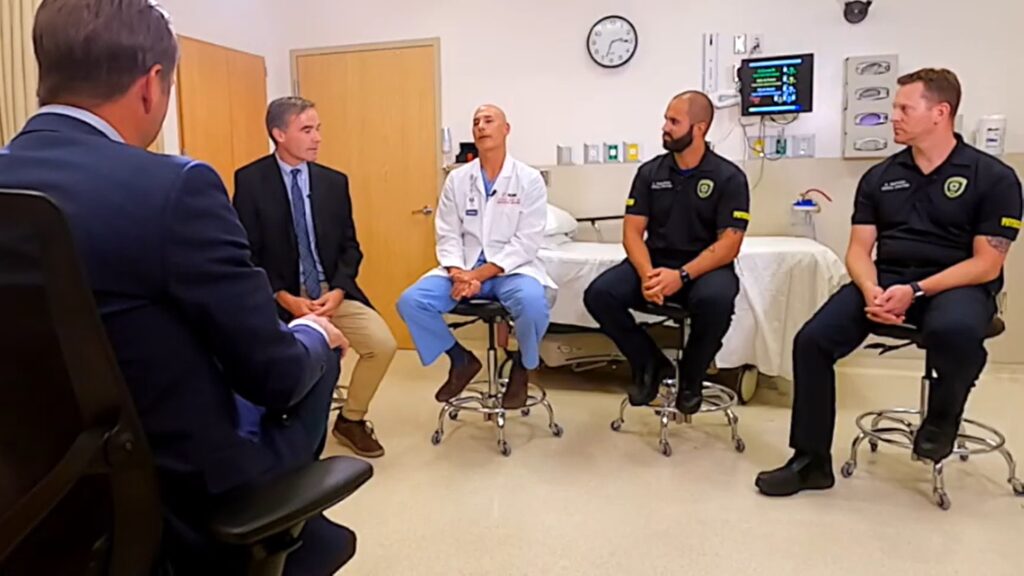ER docs on unrelenting pace of shootings in Twin Cities: ‘There’s a lot of pain’
[anvplayer video=”5144340″ station=”998122″]
On the trauma floor at the Hennepin Healthcare Medical Center in downtown Minneapolis, three letters frequently heard over the radio immediately send the emergency room into chaos:
G-S-W.
It’s short for a gunshot wound.
When the call comes in, a team of surgeons, doctors, and nurses prepare for another patient suffering from what they define as “penetrating trauma.”
“It used to be a bar close, Thursday night, Friday, Saturday, that kind of ordeal,” said Dr. Aaron Robinson, Assistant Medical Director for Hennepin EMS.
On the trauma floor at the Hennepin Healthcare Medical Center in downtown Minneapolis, three letters frequently heard over the radio immediately send the emergency room into chaos: G-S-W. It’s short for a gunshot wound.
“But now, Tuesday afternoon, I wouldn’t be surprised to see somebody come in shot,” he said.
5 INVESTIGATES recently sat down for an extended conversation with a team of doctors from Hennepin Healthcare about how they’re handling the record surge of GSW’s this year.
“This has been the most violent I’ve ever seen it in my short career,” said Robinson, who works in the emergency room, but also responds to crime scenes in an ambulance.
Over the summer, 5 INVESTIGATES reported on the surge in gun violence – specifically on automatic gun fire.
A review of court records showed a dramatic spike in the use of extended magazines and a small, nickel-size device known as a switch – that can turn a handgun into a machine gun.
That type of firepower is leading to crime scenes like one last June in downtown Minneapolis, where 177 shell casings littered the streets.

It set a record for the most shots fired in a single shooting.
“I think it’s changed the environment,” said Dr. Nicholas Simpson, Chief Medical Director of Hennepin EMS. “I was out a couple of weekends ago and caring for someone, talking through their complaints, and then not too far away we hear a series of gunshots.
“That has become somewhat commonplace and it’s uncomfortable,” he said.
HCMC’s own data shows that the level of penetrating trauma – including gunshot wounds – spiked considerably in 2020 and it remains at alarming levels today.
At this hospital, the numbers average out to one or two patients of penetrating trauma every day.
‘Murderapolis’ Comparisons
Dr. James Miner, the head of the ER at HCMC, said he has not treated this level of violence since he first started there in the mid 1990’s — when Minneapolis developed the nickname “Murderapolis.”
The moniker put the city in the national spotlight for the record-setting number of homicides that overwhelmed both police and doctors.
“This feels a lot more like it felt in the 90s,” said Dr. Miner. “When I first started, we saw a lot of penetrating trauma from a lot of gang violence in Minneapolis at the time.”
Miner said the level of trauma related to gunfire subsided in the 2000’s.
“Our typical trauma patient was a car accident or lots of ATV snowmobiles, mostly related to drinking more than violence,” he said.
But that’s no longer the case.
Among the troubling cases are the ones who doctors recognize from a previous visit.
“I can’t tell how many times I’ve opened somebody’s shirt, and there’s a couple healed wounds around the one that we’re taking care of,” said Dr. Miner.
Miner’s colleague, Dr. Thomas Wyatt, added that these types of repeat cases fit into a category of their own.
“There’s an old saying when I was in training, that trauma is a disease, meaning that patients that happen to have penetrating injuries are at higher risk for having another penetrating injury,” he said.
But the doctors who sat down with 5 INVESTIGATES all agree that by far the most troubling cases that come through the doors of the ER are the ones that involve children.
“We see a lot more injured kids than anyone should have to see,” Miner said.